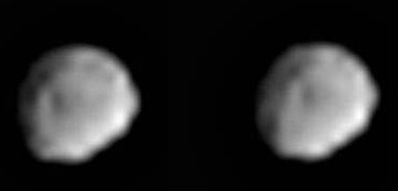
Vesta within touching distance for Dawn
KEITH COOPER
ASTRONOMY NOW
Posted: 14 June 2011


Vesta is beginning to loom in Dawn’s sights as the NASA spacecraft moves ever closer to its destination, with arrival in orbit around the asteroid scheduled for 16 July. The new images, although blurry, are the best pictures yet of the asteroid and offer tantalising clues as to what Dawn will find when it reaches Vesta.

The new pictures of Vesta, snapped by Dawn on 1 June. Images: NASA/JPL–Caltech/UCLA/MPS/DLR/IDA.
The new images were taken on 1 June and, after processing by Max Planck Institute duo Dr Vishnu Reddy and Dr Lucille Le Corre, show an unidentified dark spot about 100 kilometres across near Vesta’s equator. “We won’t know what this dark spot is for a few weeks, when we have come a bit closer to the asteroid,” says Reddy.
In total the asteroid has dimensions of 578 x 560 x 458 kilometres, and each pixel in the new images represents 45 kilometres. This, however, will gradually improve as Dawn cruises towards Vesta at the “speed of a fast airplane,” according to the mission’s principal investigator, Professor Christopher Russell of the University of California, Los Angeles. “We’ve slowed down and when we get to Vesta we’ll have matched our orbit exactly with Vesta, and just slip into orbit around it,” he says.
When that happens on 16 July, Dawn will become the first ever space mission to orbit an asteroid in the main Asteroid Belt between Mars and Jupiter. Vesta is an important object to study because it is believed to be an ancient relic from the planet-building phase at the ‘dawn’ of the Solar System, and hence it can tell us about the components that went into building our own planet, Earth.
“We think of Vesta as a protoplanet, which is a body that didn’t grow as large as a planet,” Russell tells Astronomy Now. “We’re interested in these things that were headed towards being planetary in size and then stopped because these are the last survivors that made it through the period of collisions in the Asteroid Belt without getting destroyed.”
Vesta almost didn’t make it beyond that point. It sports a massive 456-kilometre wide impact crater that is the result of a collision that almost smashed Vesta apart. Fortunately for us, the crater is up to 25-kilometres deep, allowing a look at Vesta’s composition far beneath the surface, and will be a key target during Dawn’s one-year stay at the asteroid. The crater is hinted at in the lower right of the new images.
After leaving Vesta in 2012, Dawn will fly-on to rendezvous with the largest asteroid, Ceres – another protoplanet, one that is believed to be very different to Vesta with significant quantities of water–ice – in 2015. You can read an exclusive report on the Dawn mission in the new July 2011 issue of Astronomy Now, on sale 16 June.
|



